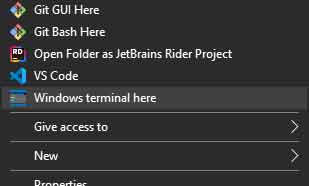I saw this tweet yesterday by Jan de Vries. He shared a trick to press [CTRL]+[L] in the windows explorer to changes the focus to the navbar, where you can type wt -d . (don’t forget the trailing period) in order to open a windows terminal window in your current location.
Now I’ve been working with the Windows Terminal for quite some time, and love it. But I had the same need, open a windows terminal in a directory I’m currently browsing with my Windows Explorer.
I know in previous installers of VS Code, there was this option you could check, to add a context menu item in Windows Explorer to open the folder in VS Code and I wanted the same for the Windows Terminal. So I did some investigations and ended up with a couple of registry entries.
Windows Terminal
 Open your registry editor and navigate to
Open your registry editor and navigate to Computer\HKEY_CLASSES_ROOT\Directory\Background\shell. I added a new key (which appears as a folder) called wt (Windows Terminal). If you select this new key, you’ll see a string value called (Default). Double click it and change the value to ‘Windows Terminal here’.
Then create a sub-key as a child of this wt key, called command. Again, if you select it, you will see a string value called (Default). Double click that to change its value and point it to your windows terminal executable, followed by the -d . arguments to open it in the given directory. The default path to wt.exe is C:\Users\[YOUR USERNAME]\AppData\Local\Microsoft\WindowsApps\wt.exe -d . (please don’t forget to replace [YOUR USERNAME] with your actual Windows username).
Bonus material
I’ve created a .reg file which you can edit and insert the values instantly. This .reg file is renamed to .txt for safety reasons. You can download a ZIP package right here. Note this package also contains an icon file. In case you want to have a nice icon next to the ‘Windows Terminal here’ option, copy and paste that icon to a convenient place on your computer. Navigate to the wt key in the registry and add a new String Value entry called Icon and change its value to the path where you copied the icon to.
Congratulations, you are now the proud owner of a ‘Windows Terminal here’ context menu!
Last modified on 2020-10-22

